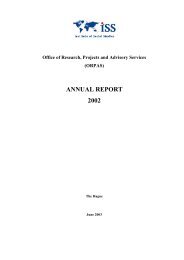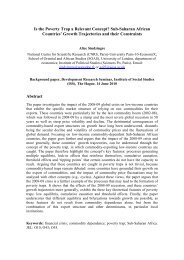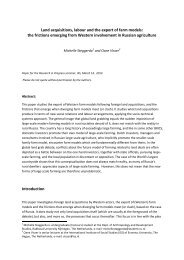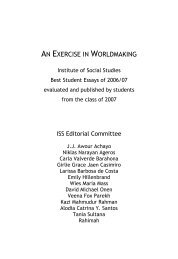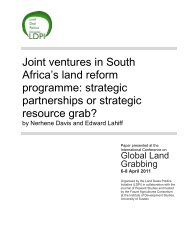AN EXERCISE IN WORLDMAKING 2009 - ISS
AN EXERCISE IN WORLDMAKING 2009 - ISS
AN EXERCISE IN WORLDMAKING 2009 - ISS
Create successful ePaper yourself
Turn your PDF publications into a flip-book with our unique Google optimized e-Paper software.
15 Reimagining Reproductive Health Interventions 173<br />
WHY WORK<strong>IN</strong>G WITH MEN IS IMPORT<strong>AN</strong>T <strong>AN</strong>D WHY WORK<strong>IN</strong>G AROUND<br />
MEN IS NOT EFFECTIVE<br />
Men were of little interest in the family planning and RH field for a long<br />
time, being left out of research and assumed to have minimal roles in<br />
fertility decisions and behavior. Most programs and interventions had<br />
women at the center as primary caregivers and child bearers, as well the<br />
main actors in reproductive decision-making. Men were seen as having<br />
uneducated and irresponsible behavior regarding fertility control, blocking<br />
female contraception, being sexually promiscuous, and underinvesting<br />
in their children’s lives (Greene 2000). In general, programs<br />
operated in a normative fashion, believing male resistance to family<br />
planning and SRH to be an unchanging fact. Such an attitude reinforced<br />
men’s non-involvement, permitting men to be disengaged from reproductive<br />
activities (ibid.). But sharing SRH information and contraception<br />
through gender-specific channels will never address problems of unplanned<br />
pregnancies, HIV/AIDS infection, and STIs that affect and<br />
devastate the lives of both men and women (AGI 2003: 7). For instance,<br />
HIV/AIDS can never be tackled without researching and understanding<br />
the sexual behavior of men; high incidences of sexual violence towards<br />
women will not be adequately understood or handled without understanding<br />
the perpetrators and digging down into the root causes for such<br />
violence. Unwanted and high-risk pregnancies and their possible outcomes<br />
of dangerous abortions and the need for ante-natal care will never<br />
be controlled if the decision-making locus involving strong culturallydefined<br />
gender relations is not understood and adopted as part of the<br />
framework of SRH programs (Dixon-Mueller & Germain 2000: 73).<br />
Understanding that reproduction is a stratified social process, not just<br />
a biological act is central to understanding that SRH programs must involve<br />
both men and women. The decisions surrounding reproduction lie<br />
within a social context involving individuals who live with the reality of<br />
inequalities based on gender and class. Men and women live in socioeconomic<br />
climates full of uncertainties; they live in cultures that many<br />
times define their roles as men and women. The reality of difficult political<br />
and economic climates make it difficult for such notions of being a<br />
‘real man’ or a ‘real woman’ to actually be attained (Keysers <strong>2009</strong>a).<br />
Men’s ‘irresponsible’ or ‘disinterested’ behavior towards SRH is not<br />
something that is static: behaviors are contextual and not necessarily biological<br />
and unchanging. Therefore, men’s risky behaviors must be under-




